Bully sticks are popular chew treats for dogs that offer numerous benefits. Made from dried bull or steer pizzle, these long-lasting treats are delicious and provide a satisfying chewing experience for dogs of all sizes.
With their natural composition and high protein content, bully sticks are a healthy and enjoyable option to keep your canine companion entertained and promote dental health. What are they, though? Most dog owners will struggle to describe them and what benefits they offer their furry pets.
Dogs seem to love them, but are bully sticks safe for dogs? Indeed, bully sticks are safe for dogs, but you must still follow some safety measures. Let’s delve into everything about bully sticks, from the safe amounts to give to what good they can do for your dog.
What Are Bully Sticks and Are They Safe for Dogs?
Pet treats have become a significant part of the dog industry. Many owners now prioritize offering their dogs and other pets treats. The treats vary from wheat products like hard biscuits to skeletal muscles from cows like rawhide chews.
The latest in a long line of pet treats are bully sticks. Bully sticks, or pizzle, are highly nutritional all-natural beef tendons made explicitly from bull penises. That explains the “sticks” part of their name.
Many manufacturers are usually ambiguous when mentioning what makes bully sticks, often naming them cow muscle or beef sticks. However, owners don’t seem to have an issue with that as long as they are a healthy treat for their pets – which they are.
Beef pizzles are excellent alternatives for owners tired of their dogs quickly chewing through rawhide and other chewable products. In contrast to household fixtures or synthetic materials, beef sticks are both digestible and highly nutritious.
That proves them to be safe for dogs. However, there are some precautions you need to take whenever you’re giving your dog a beef stick. Because they’re stiff, puppies or small dogs can easily choke on them. The pizzles, especially when small, could tempt the dog into eating them up whole.
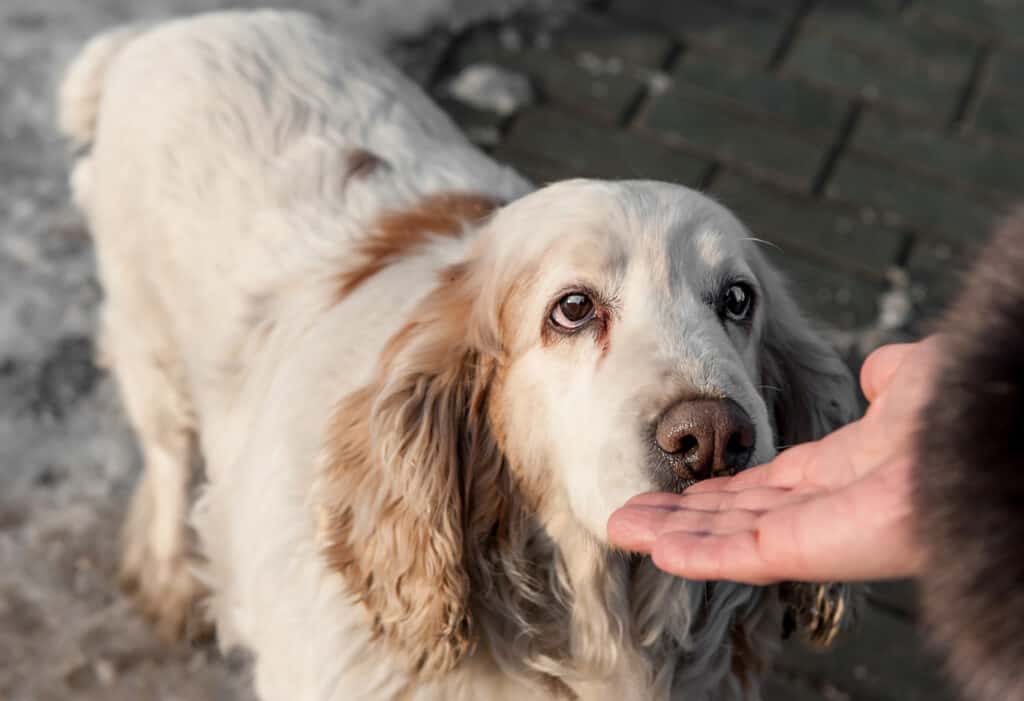
Beef pizzles are easily digestible and nutritious, making them the perfect alternative to chewable products.
©Medvedeva Oxana/Shutterstock.com
The Benefits of Bully Sticks
Bully sticks are some of the healthiest dog treats you can give your pet. These are the health benefits of giving your dog bully sticks regularly.
1. Bully Sticks Help Clean Your Dog’s Teeth
A significant benefit of giving bully sticks to your dog is their positive effect on dental health. Research shows that beef sticks reduce oral bacteria in dogs. When a dog chews on the beef sticks, it helps eliminate tartar and cavity-causing bacteria.
Considering the primary way to prevent teeth cavities in dogs is to brush their teeth, bully sticks can make your work easier. The hardiness also promotes the development of stronger jaw muscles for your pet.
Manually brushing your pet’s teeth is a time-consuming process. Not to mention the process can be pretty stressful for the dog. However, there’s never a guarantee you’ll eliminate all the bacteria. The easier way here is to buy a beef stick to help clean teeth.
Corkscrew-shaped bully sticks are the best at cleaning the teeth of dogs.
2. Excellent For When a Dog has a Sensitive Stomach
Dogs can often have sensitive stomachs, which can be messy. Owners need to manage their dog’s diet carefully during these times. Consequently, the owners can’t offer their pets as many treats as they want.
Most treats can be counterproductive to the healing process. Bully sticks, however, are a healthy addition to the dog’s diet. They won’t make the issue worse and could even provide relief.
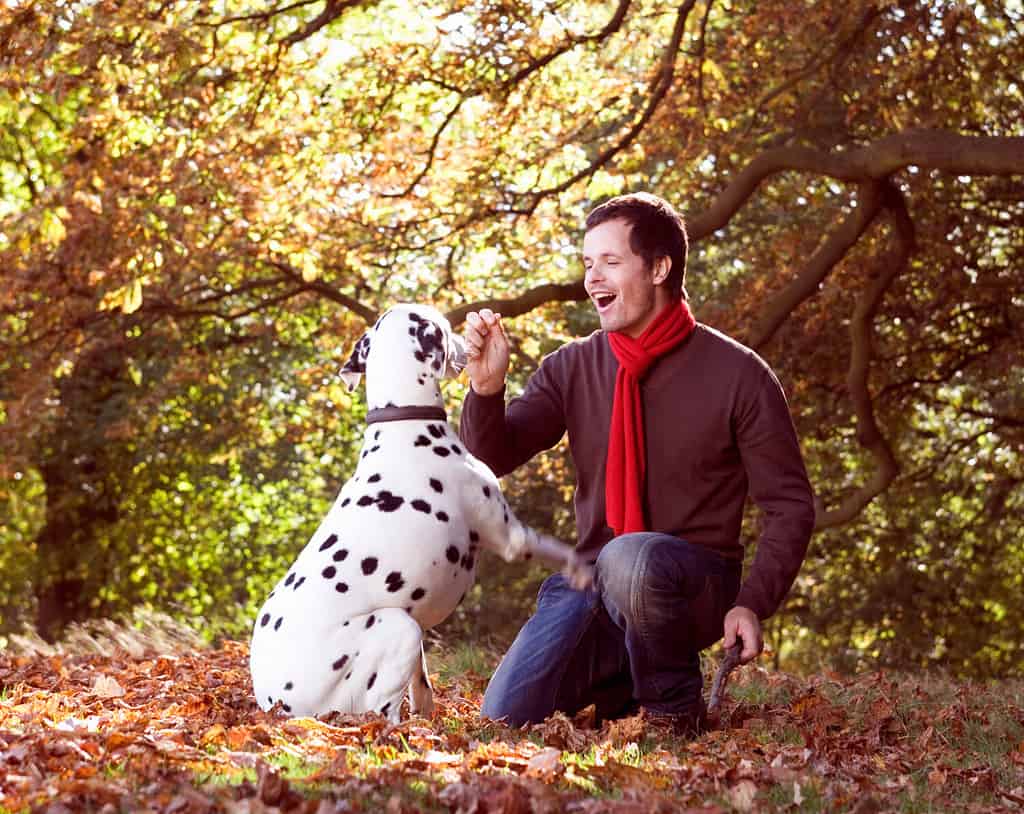
Bully sticks can be a healthy addition to your dog’s diet.
©Air Images/Shutterstock.com
3. They Are Highly Nutritious
Beef pizzles are also highly nutritious for dogs, forming part of their evolutionary diet. Dogs often feed on starchy food, which needs more nutrient balance.
The all-natural makeup of a bully stick has many veterinarians recommending them for your pet’s teeth and body health. They are also rich in taurine and carry lots of protein that would benefit your dog.
Bully sticks are also a low-fat treat, something you can’t say about most other treats. Most dog treats today contain too much sugar or wheat and therefore don’t form a healthy part of a dog’s diet.
4. Bully Treats Don’t Splinter
Another excellent quality of bully sticks is their ability not to splinter. Other treats can splinter and cause issues for your dog. That can never happen with bully sticks. That’s one reason the American Kennel Club recommends them for dogs.
5. Bully Sticks Are Satisfying
Chewing is a natural stress reliever for dogs, releasing endorphins that promote well-being and contentment. Furthermore, it is an effective way to keep dogs mentally occupied, minimizing boredom and its accompanying behavioral difficulties.
Chewing allows canines to channel their energy and attention, resulting in a more content and balanced state of mind. Offering bully sticks encourages their natural impulses and improves their mental and emotional wellness.
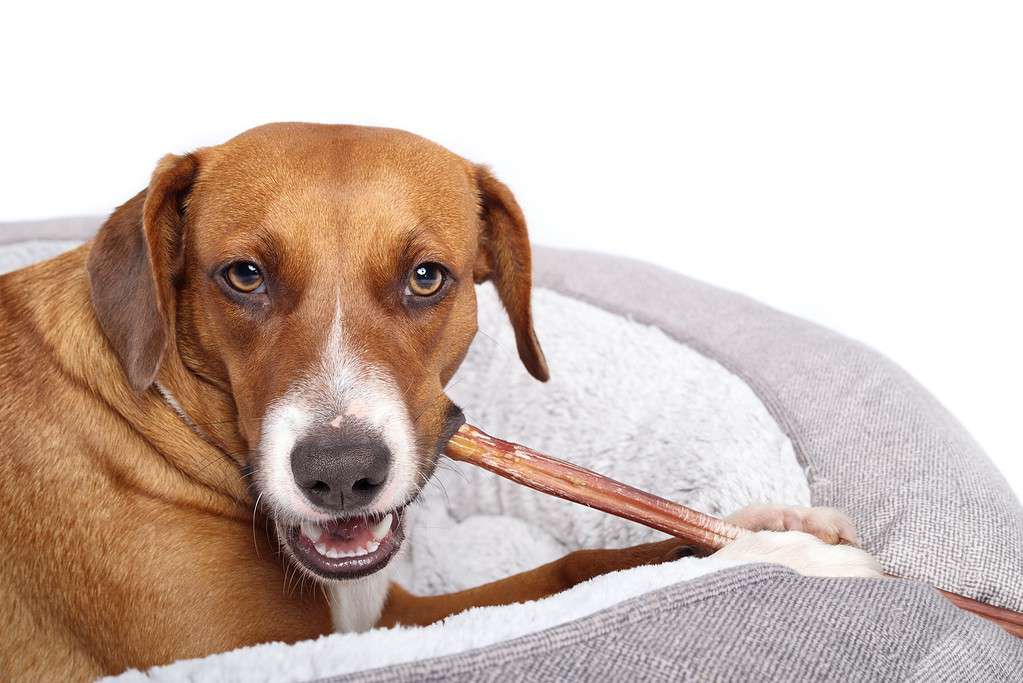
Chewing is a natural stress reliever for dogs helping to release endorphins.
©sophiecat/Shutterstock.com
Concerns About Bully Sticks
While most dog owners don’t consider treats a significant part of dog diets, bully sticks have emerged as a popular option. However, there are several concerns with bully sticks.
a) Owners Don’t Know The Specific Caloric Levels
With the obesity rate for dogs usually high, owners must know the number of calories in most things they feed to their pets. Most owners know that beef sticks are high in calories. The specific number of calories is the issue here.
Owners treat them as just snacks while they could quickly give their dog weight problems. Studies show the caloric level for bully sticks could range between 54 and 132 kcal for a six-inch pizzle and 108 to 264 for a twelve-inch pizzle.
Bully sticks contain many calories that can affect your dog’s health. It’s therefore always wise to consider the sticks as part of the dog’s diet rather than a treat. For instance, a 10-pound dog eating a bully stick covers as much as 30% of its daily caloric intake.
Coupled with other foods, too many beef sticks could be a valid concern as one of the leading causes of dog obesity.
b) Bully Sticks And The Risk Of Contamination
The same study mentioned above also raised concerns about the high rate of bacterial contamination for the bully sticks. Clostridium difficile and tetracycline-resistant E. coli are some strains isolated from samples of bully sticks. That goes to show the sticks could be prone to bacterial contamination.
That isn’t to say all bully sticks harbor microbes that could harm your dog. It only shows that dog owners should exercise caution and ensure they get their bully sticks from reputable sources.
High hygiene levels are paramount to preventing contamination of bully sticks and thus making them a healthy treat. This is the reason why it is important to buy them from the right place.
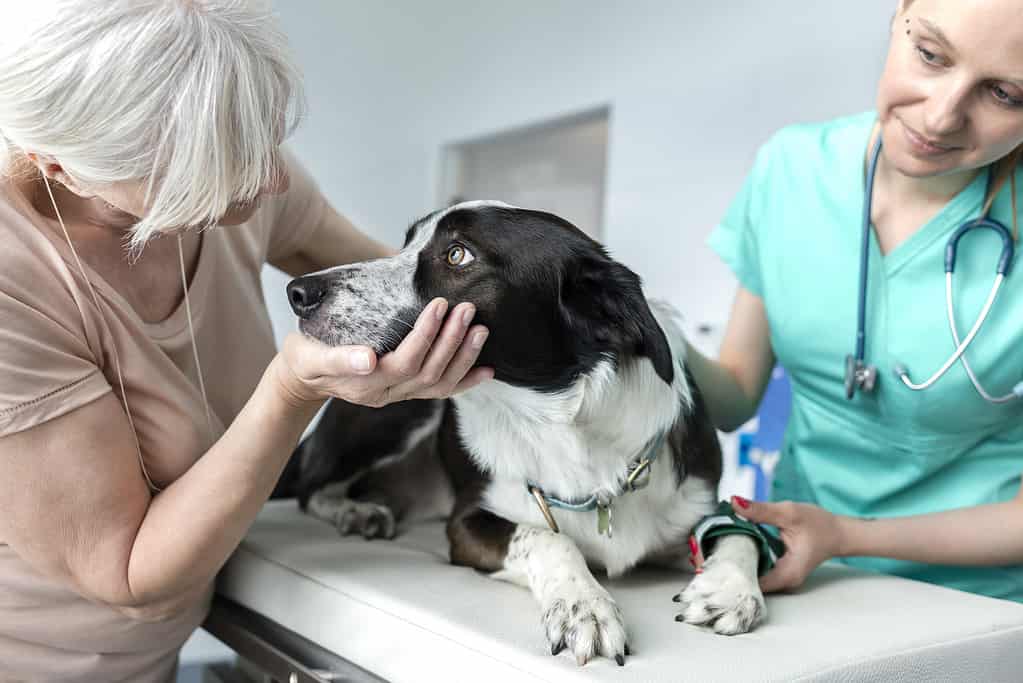
To avoid contamination of bully sticks, high hygiene levels are paramount.
©iStock.com/IPGGutenbergUKLtd
c) Bully Sticks Can Be Choking Hazards
There are different sizes for bully sticks. Dog owners often choose the size and shape they think will be ideal for their pets. However, it’s worth noting that the size of the treat you buy depends on the dog you own.
For instance, smaller dogs may benefit from thinner and shorter bully sticks, while larger dogs might require thicker and longer ones.
d) Bully Sticks Could Break Your Dog’s Teeth
The firmness of a bully stick can vary between individual sticks. Although beneficial for your dog’s dental hygiene, it is crucial to consider that overly hard bully sticks have the potential to cause tooth breakage. It is advisable to follow an unwritten rule of selecting bully sticks that are sufficiently soft for your dog’s chewing capabilities to prevent tooth breakage.
Sure, you want your dog to chew on something hard, as it’s good for the teeth. But you also have to draw a line between hard and too hard. The best way to know this is to press on the bully stick before offering it to your dog.
If you press down on the stick and your fingers create an indentation, the pizzle is soft enough. Hard beef pizzles will feel rigid. Your finger won’t be able to press down on them or even form a depression.
The above reasons are why you need to keep a close eye on your dog when you give them a treat.

Overly hard bully sticks can easily cause tooth breakage.
©Yavdat/Shutterstock.com
Are Bully Sticks Digestible?
Bully pizzles, being free of artificial preservatives and completely natural, are easily digestible, making them a great alternative to other dog chews.
It is recommended to offer bully sticks in small sizes and supervise your dog while they chew on them to avoid choking hazards.
Additionally, when your dog swallows bully sticks, they obtain their full nutritional value, unlike chewable toys or household items that they may gnaw on.
Are There Types of Bully Sticks?
Bull pizzles are usually the same, and there are no different types unless you’re talking about the sizes and shapes. In that case, bully bones can have different shapes, sizes, and lengths. A straight stick shape with a specific length is the most popular type of bully stick.
Corkscrew shapes are also a standard option. The type of pizzle shape you choose should depend on your dog’s chewing style.
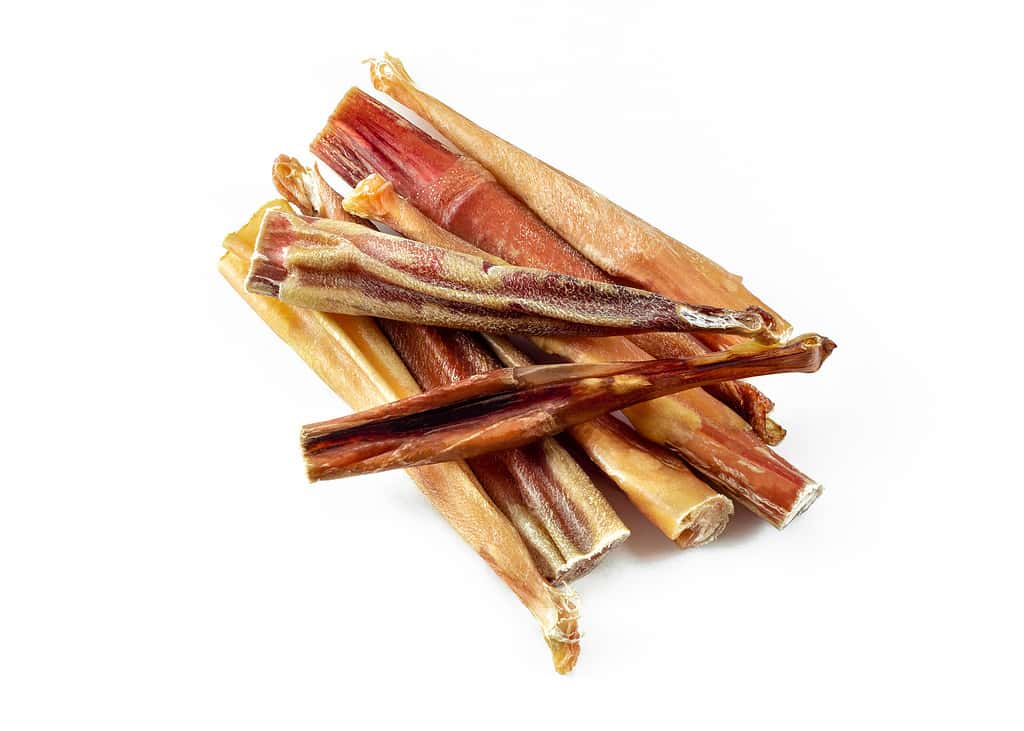
While bull pizzles remain consistent, the world of bully sticks offers a range of shapes, sizes, and lengths.
©Hajai Photo/Shutterstock.com
How to Choose Bully Sticks for Your Dog
Like any product on the market, many companies make bully sticks. How do you select the healthiest option for your dog, though?
These are factors to consider.
1. Sourcing
To ensure dietary suitability, it is important for pet owners to be aware that bully sticks should ideally be sourced from bulls or steers. However, there are unscrupulous manufacturers who may use alternative ingredients in an attempt to maximize profits. Therefore, understanding the sourcing of the stick becomes crucial for responsible pet owners in selecting appropriate options for their pets.
For optimal quality, the finest bully sticks should originate from top-grade steers or bulls. It is preferable for these source animals to be of high quality, raised in free-roaming environments, and fed a grass-fed diet. Additionally, selecting bully sticks sourced from North or South America is ideal, as it minimizes the risk of purchasing products treated with harmful chemicals.
2. Shape and Size
Traditional bull pizzles are usually straight and up to a specific length. Choose a shorter, thinner stick if you have a puppy or a small dog.
Most dogs have a shape and size that works well for them. The wrong shape or size could be disastrous for your dog since it could choke or break its teeth. Some dogs will want to swallow small pizzle sticks whole, which is risky.
So aim to strike the sweet spot when selecting a bully stick. It shouldn’t be too thick or long to choke your dog. Neither should it be too wide for the dog’s mouth.

Aim to strike the sweet spot when selecting a bully stick. It shouldn’t be too thick or long to choke your dog.
©sophiecat/Shutterstock.com
Alternatives to Bully Sticks
If you can’t get your hands on bully sticks, the following treats will prove sufficient. They are perfect for teething puppies and older dogs that need to chew on something.
Remember that there’s controversy on the right and wrong chewable material for your dog. Veterinary doctors hold differing opinions on the safety of specific products for dogs.
Raw Hides
This popular treat comes from the inner skin layer of horses or cows. Manufacturers clean and grind the hides of the animals, which they mold into dog chewables.
Sometimes manufacturers add flavors from chicken, liver, or beef to make them more appealing to dogs. The meat in raw hides can sometimes prove challenging for dogs to digest. Although not as tasty, they are an excellent alternative to bully sticks.
Dental Sticks
Dental sticks are a favorite of many dog owners who use them to reward exemplary behavior in their pets. From their name, you can tell dental sticks help maintain good dental hygiene for dogs. They eliminate bacteria and bad breath.
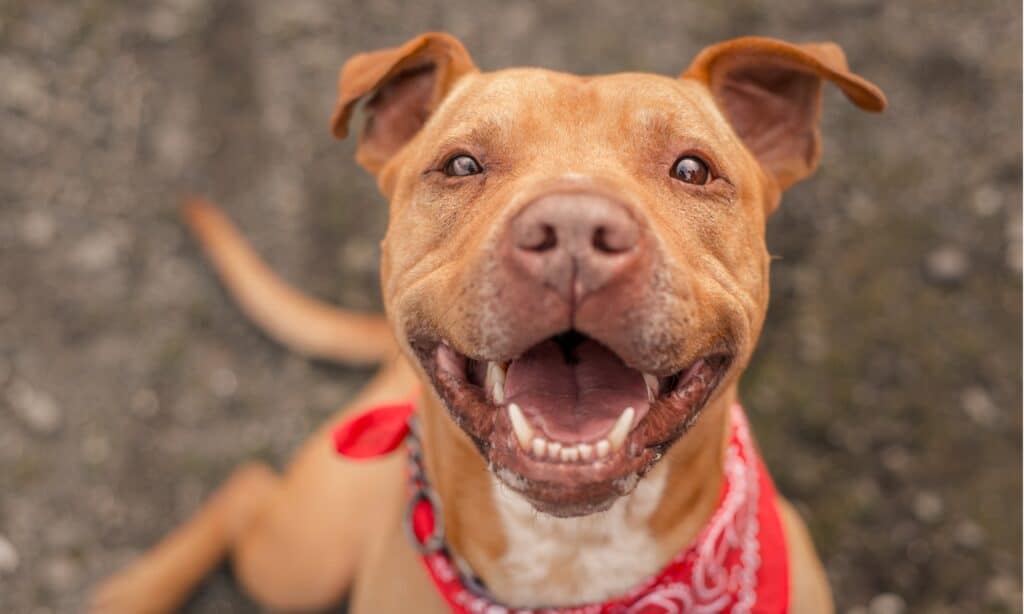
Dental sticks can help dog owners reinforce good behavior while also helping maintain dental hygiene.
©iStock.com/Photography by Adri
Synthetic Sticks
Synthetic chewable materials can be considered as an alternative for dog chewing needs. It is important to note that these materials are not digestible, and if swallowed, immediate veterinary assistance should be sought.
Deer Antlers
Deer antlers are another chewable you can offer your aggressive chewer instead of bully sticks. There’s, however, a controversy about them since they can cause teeth fractures and pose other risks. Like with bully sticks, you need to supervise your dog whenever they’re chewing deer antlers.
Raw Meaty Bones
Raw meaty bones have natural enzymes that help break down bacteria. As your dog chews on the bone it helps to remove plaque leading to better dental health.
Do All Dogs Love Bully Sticks?
Bully sticks aren’t just another healthy option to force on your dog. Dogs love them! They’re tasty, give the dogs a diverse chewing challenge, and contain any dog’s favorite food: meat!
Not only do they work for adult dogs, but they’re also perfect for small puppies as long as they can chew. Your dog will also love these sticks, as there are all kinds of shapes and sizes to fit any chewer.
Slow chewers will find straight sticks the best as they chew them. On the other hand, aggressive, fast chewers will derive much joy from chewing braided sticks.
If you need to make the challenger harder, you also choose bully rings or bullies with complex shapes to give your dog a delightful pizzle.

Bully sticks work for all types of dogs. Whether a small puppy or an older dog.
©Branislav Nenin/Shutterstock.com
Bully Sticks Are a Safe Chewable for Dogs
In conclusion, bully sticks are widely regarded as a safe chewable option for dogs. Their all-natural composition, lacking artificial preservatives, makes them easily digestible, promoting better dental hygiene and providing a satisfying chewing experience for dogs.
However, it is crucial for pet owners to select bully sticks sourced from reputable manufacturers and ensure the appropriate size to prevent choking hazards.
By considering dietary suitability, quality sourcing, and responsible supervision, bully sticks can be a reliable and enjoyable choice for dog owners seeking a safe and beneficial chewable for their furry companions.
The photo featured at the top of this post is © GoodFocused/Shutterstock.com
Ready to discover the top 10 cutest dog breeds in the entire world?
How about the fastest dogs, the largest dogs and those that are -- quite frankly -- just the kindest dogs on the planet? Each day, AZ Animals sends out lists just like this to our thousands of email subscribers. And the best part? It's FREE. Join today by entering your email below.
Thank you for reading! Have some feedback for us? Contact the AZ Animals editorial team.







